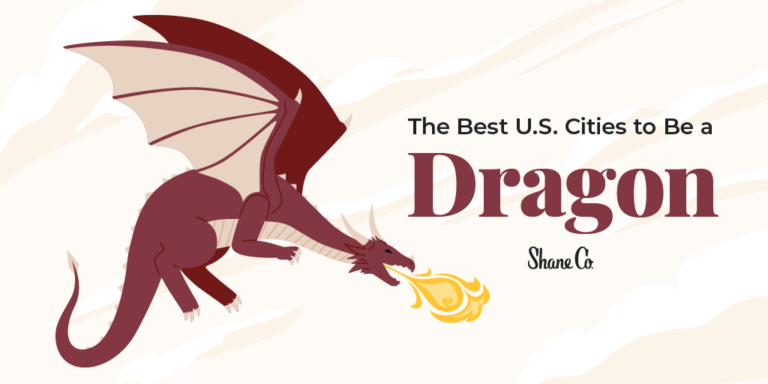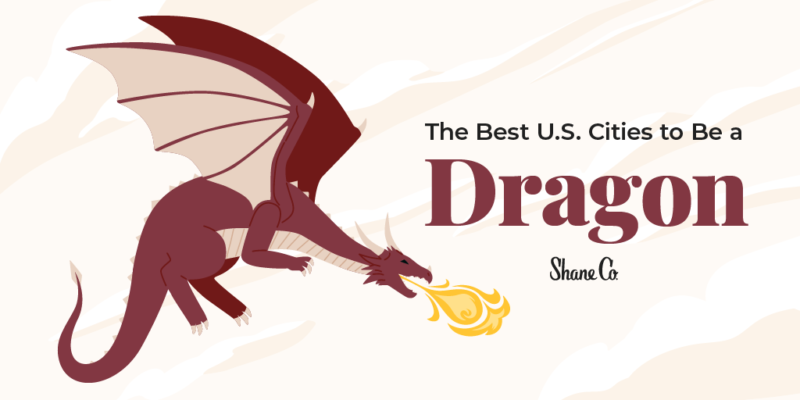


From the recent release of the new Game of Thrones spin-off, House of the Dragon, to the rapidly approaching Renaissance fair season, it feels like the time of the dragon is upon us. In the spirit of some autumn date nights that might be dragon-themed in the coming months, the team here at Shane Co. wanted to explore the idea of these folk legends a little more.
While dragons are (almost certainly) not real, we decided to play a little “what if…” and map out the regions of the U.S. where they would be most likely to thrive. From habitats to food sources to treasure hotspots, we considered it all. Find out where your city ranks among the best to be an American dragon!
Key Findings
- American dragons would flock to Western cities. The higher elevations and large parkland areas of cities like Albuquerque, New Mexico; Las Vegas, Nevada; and Provo, Utah, create the ideal dragon habitat.
- The worst cities for dragons include Indianapolis, Indiana; Philadelphia, Pennsylvania; and Columbia, South Carolina, due to their lower elevations, fewer food sources, and lack of parkland.
What Does a Dragon Look For in a City?
When considering the most ideal areas of the U.S. for a dragon to make their home, it’s important to know a few things. Dragons would favor areas of high elevation, places with plenty of parkland and relatively low greenhouse gas (GHG) emissions for a clean environment, and cities that don’t have many aviation facilities clogging up their airspace. We also considered nearby mountain peaks and bodies of fresh water.
Cities with higher population density, fewer physically active people, and tons of cattle per capita performed better in our ranking because the dragons wouldn’t want to work too hard when dinner time comes around. When on the hunt, the higher the number of homes without basements, the better…gulp! There’s no place to hide!
Fire-breathing dragons would want to avoid areas with too many fire departments and military bases because they would stop the dragon from wreaking havoc. They are also said to hoard treasure, so cities with plenty of pawn shops and jewelry stores per capita are favored on our list. Finally, dragons would want to go where they are most adored, so regions of the U.S. that search for dragons more often than others performed better in our ranking.
Where in the U.S. Would We Find a Dragon?
Given the very scientific reasons listed above, it should come as no real surprise that they would flock to the mountainous regions of the Western U.S. where there is plenty of space to roam and high peaks for them to roost.
Specifically, they might like the number of cattle available for grazing in Albuquerque, New Mexico (61 cattle per 100 people), and Boise, Idaho (116 cattle per 100 people). Provo, Utah, and El Paso, Texas, offer a ton of parkland for dragons to really get out and stretch their wings, with both cities having over 19% of their land area covered by parks.
Denver, Colorado, and Ogden, Utah, both have a relatively low number of fire stations per capita and statewide military presence, meaning there wouldn’t be much stopping a dragon from doing what it pleases. Meanwhile, the wealth that flows in and out of Las Vegas, Nevada, would attract dragons in droves.
On the other hand, some metro areas in the Eastern U.S. are particularly well-defended against a dragon invasion. Take Philadelphia, Pennsylvania, for example. The City of Brotherly Love offers next to nothing for a dragon with a low elevation, tons of aviation facilities (26 in total), plenty of homes with basements, and relatively high GHG emissions.
The lack of pawn shops and jewelry stores per capita in cities like Indianapolis, Indiana, and Baltimore, Maryland, would leave a dragon with nothing to hoard. The lack of parkland, cattle, and wider population spread of cities like Columbia, South Carolina, and Baton Rouge, Louisiana, would have a dragon packing up its treasure trove and flying west!
The 10 Cities That Best Set Dragons Up for Success
Let’s take a closer look at what makes our top 10 cities such a hotspot for dragons, starting with Albuquerque, New Mexico.
The Duke City is particularly well-positioned for dragon inhabitants, both environmentally and socially. Its elevation, parkland coverage, lack of homes with basements, and few aviation facilities make it the ideal landing spot for a dragon looking to settle down and find a forever home.
Las Vegas, Nevada, would be favored by dragons due to the wealth that flows in and out of the city regularly. On top of that, Sin City has few fire departments per capita so people aren’t constantly putting out a dragon’s handiwork, and it has a dense population, meaning dinner would be easier to come by.
Honolulu, Hawaii, cracks our top five cities thanks to high peaks (like Mauna Kea) and the fact that residents of Hawaii adore dragons, according to their Google search interest — the highest of any state. The relatively low GHG emissions per acre and relatively few statewide military bases help sneak Colorado Springs, Colorado, into our top 10 cities.
In short, dragons prefer their cities to be high in the sky with plenty of park areas to loom over, have plenty of (but not too many) people roaming around, and be lacking in disaster planning so their fires aren’t always being put out too quickly. That’s why the dragon community would concentrate its population in the West, but stop short of smog-riddled big cities and areas where others are also trying to take to the sky.
Methodology
To determine the cities that dragons would most thrive in, we began by creating a list of 100 of the largest metro areas in the U.S. and researched factors on each that would be important for the quality of life of a dragon. Once we compiled the data, we analyzed it and ranked the cities from 1 to 100 based on their ability to give a dragon a good home.
We assigned cities with a score of 0 to 5 for each factor we researched, with a score of 5 representing the most favorable conditions. We then determined each city’s score from the total of its factor scores, which were weighted according to their impact on dragon livability. Individual factor scores were then added up to give each city a final score from 0 to 100. Higher scores indicate cities that offer a better quality of life for dragons. Details on our ranking factors can be found below.
| Ranking Factor | Weight | Source |
| Number of Fire Departments per Capita | 2.00 | U.S. Fire Administration |
| Population Density | 2.00 | Governing.com |
| Nearby Aviation Facilities | 1.50 | Global Air |
| Pawn Shops | 1.00 | Bravo Pawn Systems |
| Jewelry Stores | 1.50 | Yellow Pages |
| Physically Inactive Population (%) | 1.00 | CDC |
| Elevation | 1.50 | City-Data |
| Search Interest for Dragons | 0.50 | Google Trends |
| Number of Cattle per Capita | 2.00 | Beef 2 Live |
| Number of Military Bases by State | 1.00 | MilitaryBases.com |
| Parkland Coverage | 2.50 | TPL |
| Homes Listed with a Basement per Capita | 0.50 | Zillow |
| Greenhouse Gas Emissions per Acre | 1.00 | CNT |
| Land Area Covered by Water by State | 0.50 | Geography Realm |
| Highest Peak by State | 1.50 | Peakbagger |
Closing Thoughts
Dragons are a centerpiece of folktales and legends around the world and often symbolize valiance, bravery, and self-confidence. All traits that the team here at Shane Co. knows are incredibly important when it comes to popping the biggest question. Once you and your partner are ready to take the next big step, shop Shane Co.’s assortment of engagement rings that even the greediest of dragons would be jealous of.


